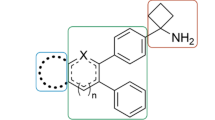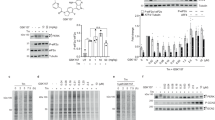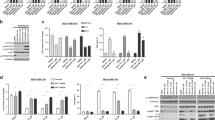Abstract
The kinase Akt plays a central role as a regulator of multiple growth factor input signals, thus making it an attractive anticancer drug target. A-443654 is an ATP-competitive Akt inhibitor. Unexpectedly, treatment of cells with A-443654 causes paradoxical hyperphosphorylation of Akt at its two regulatory sites (Thr308 and Ser473). We explored whether inhibitor-induced hyperphosphorylation of Akt by A-443654 is a consequence of disrupted feedback regulation at a pathway level or whether it is a direct consequence of inhibitor binding to the ATP binding site of Akt. Catalytically inactive mutants of Akt revealed that binding of an inhibitor to the ATP site of Akt is sufficient to directly cause hyperphosphorylation of the kinase in the absence of any pathway feedback effects. We conclude that ATP-competitive Akt inhibitors impart regulatory phosphorylation of their target kinase Akt. These results provide new insights into both natural regulation of Akt activation and Akt inhibitors entering the clinic.
This is a preview of subscription content, access via your institution
Access options
Subscribe to this journal
Receive 12 print issues and online access
$259.00 per year
only $21.58 per issue
Buy this article
- Purchase on Springer Link
- Instant access to full article PDF
Prices may be subject to local taxes which are calculated during checkout






Similar content being viewed by others
Accession codes
References
Engelman, J.A., Luo, J. & Cantley, L.C. The evolution of phosphatidylinositol 3-kinases as regulators of growth and metabolism. Nat. Rev. Genet. 7, 606–619 (2006).
Manning, B.D. & Cantley, L.C. AKT/PKB signaling: navigating downstream. Cell 129, 1261–1274 (2007).
Hennessy, B.T., Smith, D.L., Ram, P.T., Lu, Y. & Mills, G.B. Exploiting the PI3K/AKT pathway for cancer drug discovery. Nat. Rev. Drug Discov. 4, 988–1004 (2005).
Alessi, D.R. et al. Characterization of a 3-phosphoinositide-dependent protein kinase which phosphorylates and activates protein kinase Balpha. Curr. Biol. 7, 261–269 (1997).
Stokoe, D. et al. Dual role of phosphatidylinositol-3,4,5-trisphosphate in the activation of protein kinase B. Science 277, 567–570 (1997).
Alessi, D.R. et al. Mechanism of activation of protein kinase B by insulin and IGF-1. EMBO J. 15, 6541–6551 (1996).
Sarbassov, D.D., Guertin, D.A., Ali, S.M. & Sabatini, D.M. Phosphorylation and regulation of Akt/PKB by the rictor-mTOR complex. Science 307, 1098–1101 (2005).
Apsel, B. et al. Targeted polypharmacology: discovery of dual inhibitors of tyrosine and phosphoinositide kinases. Nat. Chem. Biol. 4, 691–699 (2008).
Carpten, J.D. et al. A transforming mutation in the pleckstrin homology domain of AKT1 in cancer. Nature 448, 439–444 (2007).
Shor, A.C., Agresta, S.V., D'Amato, G.Z. & Sondak, V.K. Therapeutic potential of directed tyrosine kinase inhibitor therapy in sarcomas. Cancer Control 15, 47–54 (2008).
Fresno Vara, J.A. et al. PI3K/Akt signalling pathway and cancer. Cancer Treat. Rev. 30, 193–204 (2004).
Cheng, J.Q., Lindsley, C.W., Cheng, G.Z., Yang, H. & Nicosia, S.V. The Akt/PKB pathway: molecular target for cancer drug discovery. Oncogene 24, 7482–7492 (2005).
Marone, R., Cmiljanovic, V., Giese, B. & Wymann, M.P. Targeting phosphoinositide 3-kinase: moving towards therapy. Biochim. Biophys. Acta 1784, 159–185 (2008).
Faivre, S., Kroemer, G. & Raymond, E. Current development of mTOR inhibitors as anticancer agents. Nat. Rev. Drug Discov. 5, 671–688 (2006).
O'Reilly, K.E. et al. mTOR inhibition induces upstream receptor tyrosine kinase signaling and activates Akt. Cancer Res. 66, 1500–1508 (2006).
Shah, O.J., Wang, Z. & Hunter, T. Inappropriate activation of the TSC/Rheb/mTOR/S6K cassette induces IRS1/2 depletion, insulin resistance, and cell survival deficiencies. Curr. Biol. 14, 1650–1656 (2004).
Manning, B.D. et al. Feedback inhibition of Akt signaling limits the growth of tumors lacking Tsc2. Genes Dev. 19, 1773–1778 (2005).
Um, S.H. et al. Absence of S6K1 protects against age- and diet-induced obesity while enhancing insulin sensitivity. Nature 431, 200–205 (2004).
Harrington, L.S. et al. The TSC1–2 tumor suppressor controls insulin-PI3K signaling via regulation of IRS proteins. J. Cell Biol. 166, 213–223 (2004).
Luo, Y. et al. Potent and selective inhibitors of Akt kinases slow the progress of tumors in vivo. Mol. Cancer Ther. 4, 977–986 (2005).
Han, E.K. et al. Akt inhibitor A-443654 induces rapid Akt Ser-473 phosphorylation independent of mTORC1 inhibition. Oncogene 26, 5655–5661 (2007).
Wang, L., Harris, T.E., Roth, R.A. & Lawrence, J.C. Jr. PRAS40 regulates mTORC1 kinase activity by functioning as a direct inhibitor of substrate binding. J. Biol. Chem. 282, 20036–20044 (2007).
Vander Haar, E., Lee, S.I., Bandhakavi, S., Griffin, T.J. & Kim, D.H. Insulin signalling to mTOR mediated by the Akt/PKB substrate PRAS40. Nat. Cell Biol. 9, 316–323 (2007).
Bishop, A.C. et al. A chemical switch for inhibitor-sensitive alleles of any protein kinase. Nature 407, 395–401 (2000).
Bishop, A.C. et al. Generation of monospecific nanomolar tyrosine kinase inhibitors via a chemical genetic approach. J. Am. Chem. Soc. 121, 627–631 (1999).
Miller, A.L., Zhang, C., Shokat, K.M. & Lowell, C.A. Generation of a novel system for studying spleen tyrosine kinase function in macrophages and B cells. J. Immunol. 182, 988–998 (2009).
Knight, Z.A. & Shokat, K.M. Features of selective kinase inhibitors. Chem. Biol. 12, 621–637 (2005).
Davies, T.G. et al. A structural comparison of inhibitor binding to PKB, PKA and PKA-PKB chimera. J. Mol. Biol. 367, 882–894 (2007).
Andjelković, M. et al. Role of translocation in the activation and function of protein kinase B. J. Biol. Chem. 272, 31515–31524 (1997).
Meier, R., Alessi, D.R., Cron, P., Andjelkovic, M. & Hemmings, B.A. Mitogenic activation, phosphorylation, and nuclear translocation of protein kinase Bbeta. J. Biol. Chem. 272, 30491–30497 (1997).
Knight, Z.A. et al. A pharmacological map of the PI3-K family defines a role for p110alpha in insulin signaling. Cell 125, 733–747 (2006).
Franke, T.F., Kaplan, D.R., Cantley, L.C. & Toker, A. Direct regulation of the Akt proto-oncogene product by phosphatidylinositol-3,4-bisphosphate. Science 275, 665–668 (1997).
Feldman, R.I. et al. Novel small molecule inhibitors of 3-phosphoinositide-dependent kinase-1. J. Biol. Chem. 280, 19867–19874 (2005).
Anand, N.K. et al. Preparation and structure activity of pyrazolo-pyrimidine derivatives as antitumor agents and kinase modulators. PCT application WO2005117909 (2005).
Huse, M. & Kuriyan, J. The conformational plasticity of protein kinases. Cell 109, 275–282 (2002).
Green, C.J. et al. Use of Akt inhibitor and a drug-resistant mutant validates a critical role for protein kinase B/Akt in the insulin-dependent regulation of glucose and system A amino acid uptake. J. Biol. Chem. 283, 27653–27667 (2008).
Calleja, V., Laguerre, M., Parker, P.J. & Larijani, B. Role of a novel PH-kinase domain interface in PKB/Akt regulation: structural mechanism for allosteric inhibition. PLoS Biol. 7, e17 (2009).
Kumar, S., Jiang, M.S., Adams, J.L. & Lee, J.C. Pyridinylimidazole compound SB 203580 inhibits the activity but not the activation of p38 mitogen-activated protein kinase. Biochem. Biophys. Res. Commun. 263, 825–831 (1999).
Hall-Jackson, C.A. et al. Paradoxical activation of Raf by a novel Raf inhibitor. Chem. Biol. 6, 559–568 (1999).
Levy, D.S., Kahana, J.A. & Kumar, R. AKT inhibitor, GSK690693, induces growth inhibition and apoptosis in acute lymphoblastic leukemia cell lines. Blood 113, 1723–1729 (2009).
Heerding, D.A. et al. Identification of 4-(2-(4-amino-1,2,5-oxadiazol-3-yl)-1-ethyl-7-{[(3S)-3-piperidinylmethyl]oxy-1H-imidazo[4,5-c]pyridin-4-yl)-2-methyl-3-butyn-2-ol (GSK690693), a novel inhibitor of AKT kinase. J. Med. Chem. 51, 5663–5679 (2008).
Calleja, V. et al. Intramolecular and intermolecular interactions of protein kinase B define its activation in vivo. PLoS Biol. 5, e95 (2007).
Levinson, N.M., Seeliger, M.A., Cole, P.A. & Kuriyan, J. Structural basis for the recognition of c-Src by its inactivator Csk. Cell 134, 124–134 (2008).
Du, K. & Tsichlis, P.N. Regulation of the Akt kinase by interacting proteins. Oncogene 24, 7401–7409 (2005).
Downward, J. Targeting RAS signalling pathways in cancer therapy. Nat. Rev. Cancer 3, 11–22 (2003).
Bustelo, X.R., Sauzeau, V. & Berenjeno, I.M. GTP-binding proteins of the Rho/Rac family: regulation, effectors and functions in vivo. Bioessays 29, 356–370 (2007).
Papa, F.R., Zhang, C., Shokat, K. & Walter, P. Bypassing a kinase activity with an ATP-competitive drug. Science 302, 1533–1537 (2003).
Lee, K.P. et al. Structure of the dual enzyme Ire1 reveals the basis for catalysis and regulation in nonconventional RNA splicing. Cell 132, 89–100 (2008).
Korennykh, A.V. et al. The unfolded protein response signals through high-order assembly of Ire1. Nature 457, 687–693 (2009).
Boudeau, J., Miranda-Saavedra, D., Barton, G.J. & Alessi, D.R. Emerging roles of pseudokinases. Trends Cell Biol. 16, 443–452 (2006).
Acknowledgements
We thank B. Houseman (University of California, San Francisco) for PIK90 synthesis. We thank A. Dar, M. Feldman, A. Garske and A. Statsuk for helpful comments on the manuscript. T.O. was supported by Ajinomoto Co., Inc. D.C.G. is supported by a training grant from the University of California Systemwide Biotechnology Research & Education Program GREAT (Graduate Research and Education in Adaptive bio-Technology) and by a US National Institutes of Health Chemistry and Chemical Biology Training Grant. D.F. thanks the Ernst Schering Stiftung for funding.
Author information
Authors and Affiliations
Contributions
T.O. designed and synthesized PrIDZ, determined in vitro IC50 values of PrIDZ, 3-IB-PP1 and A-443654, prepared the variants of Akt, measured in vitro kinase activity of Akt variants, performed all cell-based assays for HEK 293, HEK 293T, MiaPaCa-2, MCF-7 and PC-3 cells followed by immunoblotting, and carried out immunofluorescence microscopy experiments. C.Z. designed and synthesized 3-IB-PP1. D.F. synthesized A-443654 and BX-795. D.C.G. and D.F. synthesized DG2, measured in vitro IC50 values of DG2 and conducted cell-based assays for L6 cells followed by immunoblotting. B.A. and R.H. performed Invitrogen SelectScreen kinase profiling assays. T.O. and K.M.S. conceived the experiments and wrote the manuscript, with help from and editing by all the co-authors.
Corresponding author
Supplementary information
Supplementary Text and Figures
Supplementary Figures 1–11, Supplementary Tables 1 and 2, and Supplementary Methods (PDF 10339 kb)
Rights and permissions
About this article
Cite this article
Okuzumi, T., Fiedler, D., Zhang, C. et al. Inhibitor hijacking of Akt activation. Nat Chem Biol 5, 484–493 (2009). https://doi.org/10.1038/nchembio.183
Received:
Accepted:
Published:
Issue Date:
DOI: https://doi.org/10.1038/nchembio.183
This article is cited by
-
Computational drug repurposing of Akt-1 allosteric inhibitors for non-small cell lung cancer
Scientific Reports (2023)
-
GCN2 kinase activation by ATP-competitive kinase inhibitors
Nature Chemical Biology (2022)
-
The HSP-RTK-Akt axis mediates acquired resistance to Ganetespib in HER2-positive breast cancer
Cell Death & Disease (2021)
-
Uncovering drug repurposing candidates for head and neck cancers: insights from systematic pharmacogenomics data analysis
Scientific Reports (2021)
-
Paradoxical activation of the protein kinase-transcription factor ERK5 by ERK5 kinase inhibitors
Nature Communications (2020)



